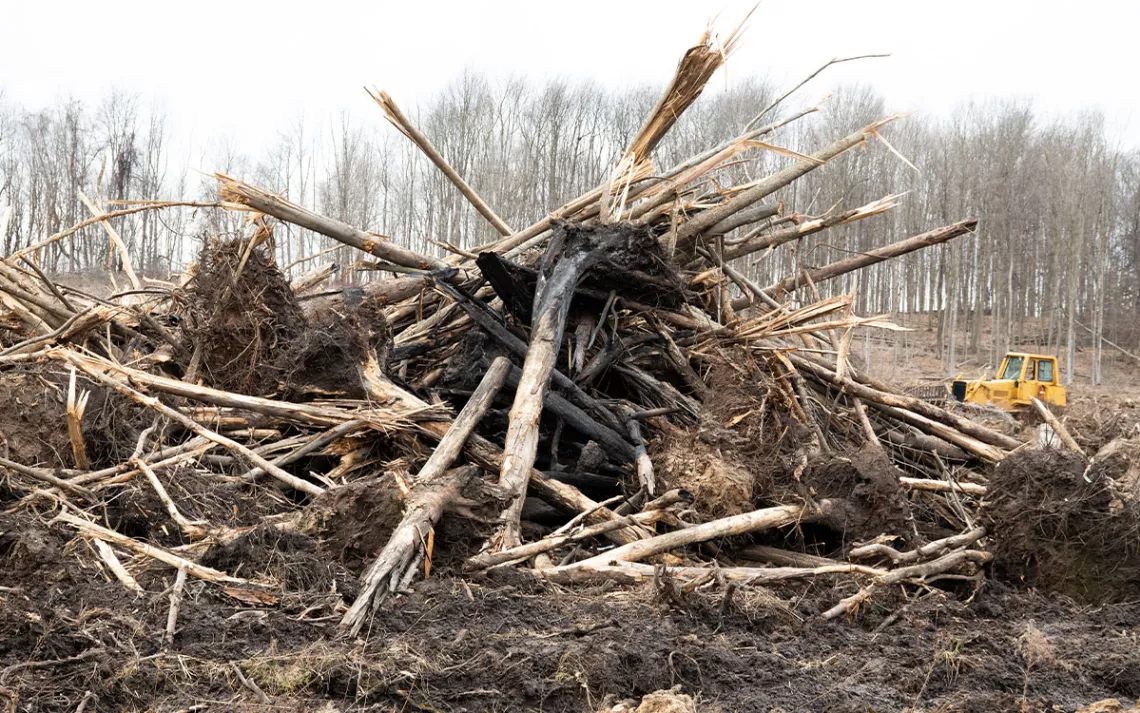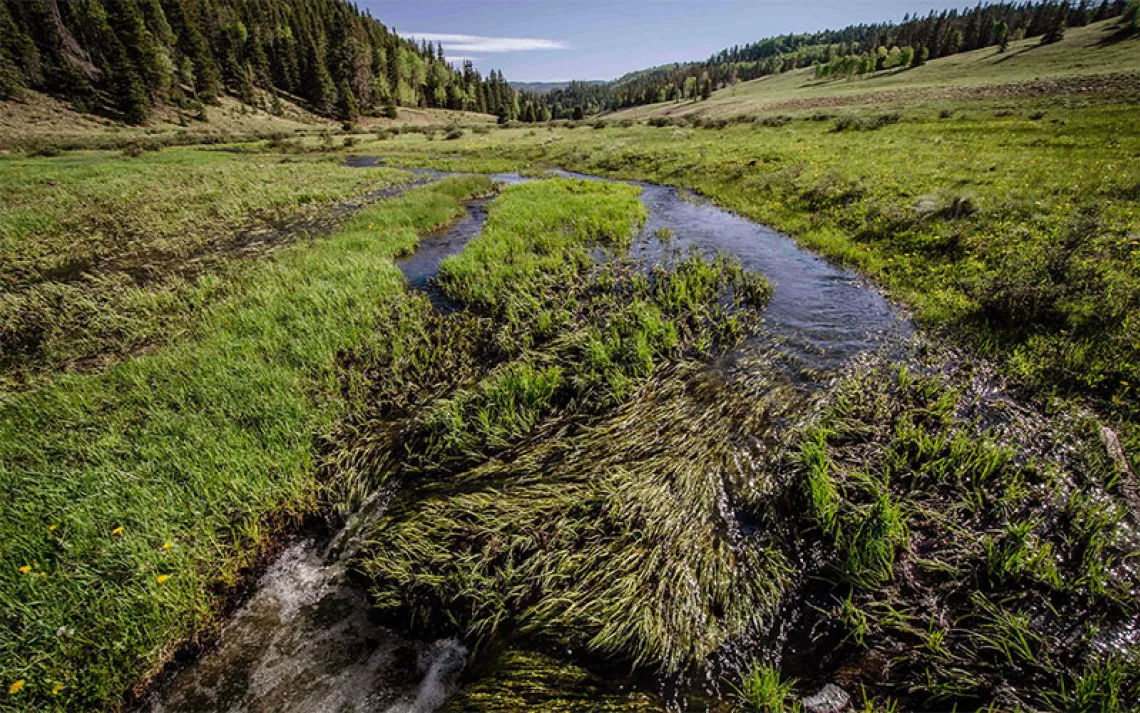Biomass Boondoggle?
Energy wildcatters are looking to turn woody forest refuse into biofuel, hydrogen, or whatever will capture generous federal incentives

Rural Oregon has lots of slash piles—and lots of entrepreneurs promising to turn that slash into gold. | Photo by JZHunt/iStock
On May 18, residents of Lakeview, Oregon, crowded into a wood-paneled community room to hear Chris Efird, CEO of NEXT Renewable Fuels, talk about Lakeview RNG, the latest biofuels enterprise that promises to bring jobs and economic opportunity to the region.
The company recently acquired the assets of Red Rock Biofuels, a sprawling mass of pipeworks, tanks, and conveyors built on the south edge of town. Red Rock was going to convert “woody slash” from forest-thinning projects into liquid jet fuel, providing dozens of local jobs in the process. Instead, the company went into foreclosure before a single gallon ever flowed.
Lakeview RNG will also use woody biomass as the plant’s feedstock, Efird explained, but instead of jet fuel, it will make “renewable natural gas” and, eventually, hydrogen. Engineers are also studying whether they can do something with the CO2 left over from the gasification process.
“If you can capture and sequester it, then you add a lot of value,” said Efird.
Efird’s crisp white button-down shirt stood out against the flannel-clad audience, but crowd was friendly: Residents sipped complimentary white wine and chuckled at Efird’s jokes, even as they asked pointed questions about the plant’s logistics, economic viability, and estimated $500 million price tag.
Sparsely populated cow country in eastern Oregon may seem an unlikely site for a cutting-edge bio-refinery, but Lake County is bullish on alternative energy. The county leads the state in solar-energy development, and years ago turned to forest stewardship projects—which emphasize forest health and water quality over merchantable timber—to keep people working in the woods. County leaders have considered various biomass energy schemes to make use of the limbs, branches, and small-diameter logs these projects generate. First it was a cogeneration plant at the county’s one remaining sawmill, then a dedicated biomass plant owned by Iberdrola Renewables. Neither was built.
When Red Rock broke ground in 2018, it was lauded as a win-win-win—a model of “healthy forests, healthy fuels” that could be replicated all over the fire-prone West. The Oregon Chapter of the Sierra Club did not take an official stance on Red Rock, although Carol Valentine, chapter Forest Team coordinator, expressed concern about the facility’s 26-acre footprint and potential carbon and human health impacts. Meanwhile, Southwest Airlines and FedEx signed contracts for millions of gallons of sustainable aviation fuel; the project landed a $75 million grant from the Department of Defense and an endorsement from Kate Brown, Oregon’s Democratic governor. But the project was plagued by cost overruns, engineering snafus, and the Covid-19 pandemic. By the end of 2022, the company owed over $350 million in principal and interest on state revenue bonds.
By resurrecting Red Rock, can Lakeview RNG finally prove that it’s possible to spin cellulose into gold?
The incentives are there, thanks to the federal government and states like Oregon and California, where low-carbon transportation fuels earn credits that can be bought and sold on the open market.
Under Oregon’s Clean Fuels Program, transportation fuels produced and sold in the state must be evaluated for their carbon intensity, or how much carbon dioxide is emitted for each unit produced. Low-carbon fuels generate credits; high-carbon fuels like conventional diesel and gasoline generate deficits. Every year the carbon intensity threshold gets lower, prompting energy companies to look beyond fossil fuels.
In Oregon, biodiesels are growing rapidly, says Cory Wind, clean fuels program manager for the Oregon Department of Environmental Quality.
“Oil companies that are historically deficit generators are becoming credit generators,” says Wind. “You’ve seen huge investments by all the companies on the West Coast by converting part or all of their operations to biodiesel.”
Alternative fuels are not without controversy. In Oregon and elsewhere, communities are souring on dairy digesters, which capture methane from immense manure lagoons but also tend to pollute water and air. And NEXT Renewables faces stiff opposition from farmers and environmental groups for another Oregon project, a $1.5 billion biodiesel plant proposed for Port Westward, which opponents say shouldn’t be built on the unstable soils near organic farms and the Columbia River.
Fuels made from woody slash are uncommon. One reason is that gathering and transporting the material to a central processing plant is costly and time-consuming. And thanks to an EPA rule, fuels made from wood sourced from federal forests cannot earn credits under the federal Renewable Fuel Standard. This means a facility like the one in Lakeview, which is surrounded by thousands of acres of national forestland, can only source from private land if it wants to snag both state and federal credits.
“Honestly, these guys need both the federal and state incentive,” says Wind. “Not having access to that federal credit makes it that much harder for them to have a business case and be economically viable.”
It’s also difficult to evaluate the carbon intensity of fuels made from wood from forests, says Kevin Fingerman, associate professor of energy and climate at Cal Poly Humboldt. The material can come from many different forest ecosystems, and part of the equation involves figuring out what would happen to that wood if it were left to decay or burn, whether deliberately in a prescribed fire or incidentally in a wildfire.
“We need the best available science to ensure that fuel pathways are delivering their intended climate benefit,” says Fingerman, who is developing a model to evaluate the full life-cycle carbon footprint of fuels made from forest biomass.
Finally, there’s a question of whether using woody stuff to make fuel is even a good idea, even if the economics do work. Proponents argue that it’s better than leaving the slash on the ground or burning it onsite, where it sends emissions directly into the atmosphere.
The Sierra Club has long strongly opposed bioelectricity, where wood is directly burned at power plants to generate electricity. Valentine acknowledges that using wood to make fuel is a different proposition, but she still advocates using the precautionary principle when evaluating biomass-to-biofuels projects, which require high energy inputs. (Lakeview RNG will use methane gas to power the super-heated gasification process.)
"It's tricky with climate change, because we have to do things much faster than we have in the past,” she says. “Maybe we do sign off on some trade-offs. But we need to have a much better understanding of the long-term impacts."
Valentine also cautions that forest-thinning projects done in the name of wildfire mitigation shouldn’t do more harm than good.
“The questions we are raising are, what are the ramifications for habitat, and what are the carbon, soil, and water impacts of hauling all of this material out of the forest?”
Dan Serres, conservation director for Columbia Riverkeeper, which is fighting the Port Westward biorefinery, thinks the Lakeview community should be wary of any enterprise associated with NEXT Renewable Fuels.
“They say one thing and do another,” he says, adding that while the Port Westward biorefinery initially had no rail component, a later proposal included a large rail yard. (Serres suspects the plan was to bring in soy and corn from the Midwest by train, even though the plant is supposed to rely on waste oils from overseas. Last year, the state denied the permit for the yard.)
“NEXT has a track record of talking big and not delivering, says Serres. “We’re in a position now that the public entities that are promoting this stuff need to take a hard look at these companies and whether these projects make sense.”
Lakeview was built on ranching and logging, and it’s understandable that residents are anxious to see new life pumped into its economy. The county’s remoteness and small size make it a tough sell for investors, even as it deals with a severe housing shortage.
In 2021, the Bootleg Fire ravaged the country west of Lakeview, eventually burning through 400,000 acres. At the May meeting, one resident asked Efird if Lakeview RNG will be able to use fire-killed wood.
Burned wood is chemically different than live wood, Efird explained; much of its energy has already been liberated. “We have done a resource study, and we have had to expand out materially the radius that Red Rock was looking at because of the fire,” Efird said. Still, he expressed confidence about the plant’s viability and his company’s ability to secure capital and lobby for changing the EPA rule on wood sourcing.
Will Lakeview RNG blaze a trail as the first industrial-scale biomass-to-biofuel plant, or will it join the list of the county’s failed enterprises? In an email, a Lakeview RNG a spokesperson confirmed that they hope to see the new plant operating by 2025, but added that they are currently “fine tuning” the engineering and are hesitant to share more details until that process is complete.
They may never have a better chance. The federal government is pouring money into alternative fuels, including generous incentives for hydrogen producers and grants for biofuels development through the Inflation Reduction Act. The energy wildcatters chasing those federal dollars just need to come up with something that works.
 The Magazine of The Sierra Club
The Magazine of The Sierra Club



